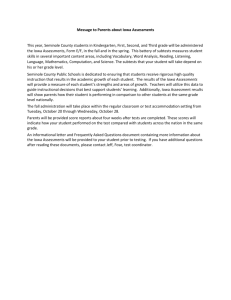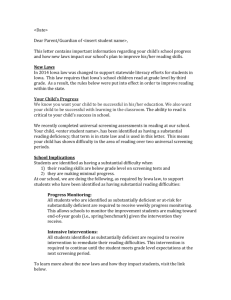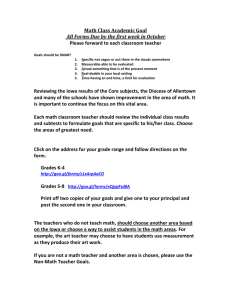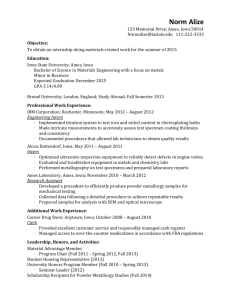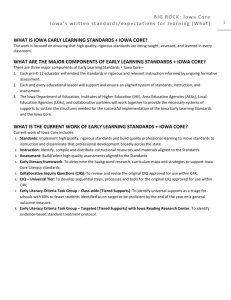agenda_LSIAC_Aug26_2014
advertisement
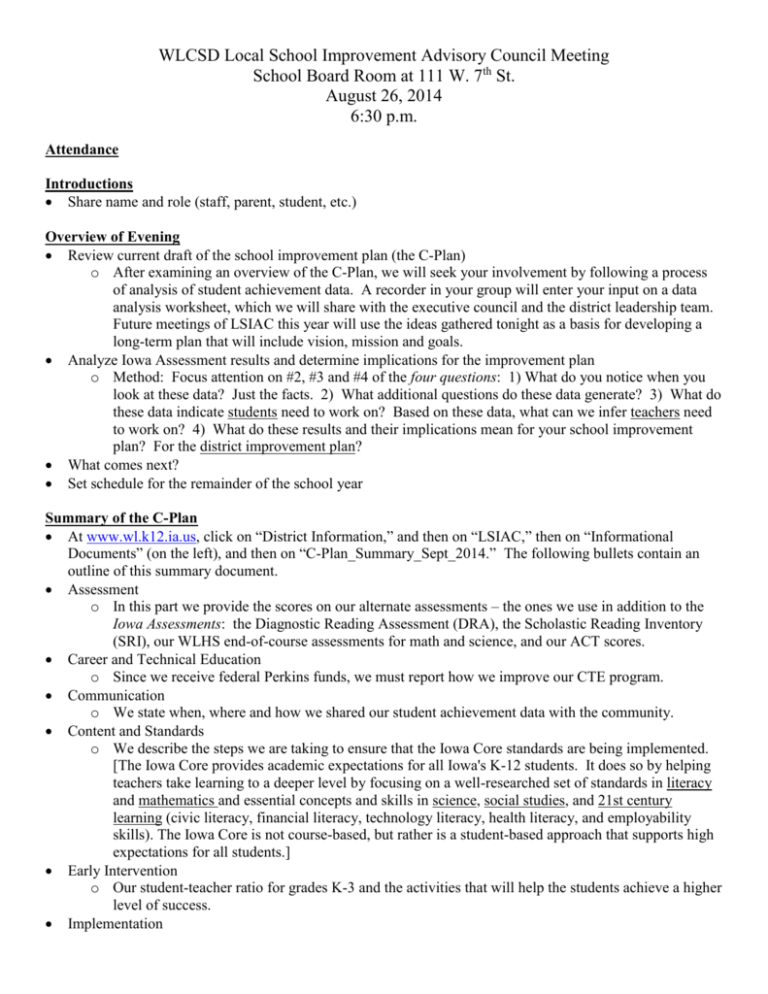
WLCSD Local School Improvement Advisory Council Meeting School Board Room at 111 W. 7th St. August 26, 2014 6:30 p.m. Attendance Introductions Share name and role (staff, parent, student, etc.) Overview of Evening Review current draft of the school improvement plan (the C-Plan) o After examining an overview of the C-Plan, we will seek your involvement by following a process of analysis of student achievement data. A recorder in your group will enter your input on a data analysis worksheet, which we will share with the executive council and the district leadership team. Future meetings of LSIAC this year will use the ideas gathered tonight as a basis for developing a long-term plan that will include vision, mission and goals. Analyze Iowa Assessment results and determine implications for the improvement plan o Method: Focus attention on #2, #3 and #4 of the four questions: 1) What do you notice when you look at these data? Just the facts. 2) What additional questions do these data generate? 3) What do these data indicate students need to work on? Based on these data, what can we infer teachers need to work on? 4) What do these results and their implications mean for your school improvement plan? For the district improvement plan? What comes next? Set schedule for the remainder of the school year Summary of the C-Plan At www.wl.k12.ia.us, click on “District Information,” and then on “LSIAC,” then on “Informational Documents” (on the left), and then on “C-Plan_Summary_Sept_2014.” The following bullets contain an outline of this summary document. Assessment o In this part we provide the scores on our alternate assessments – the ones we use in addition to the Iowa Assessments: the Diagnostic Reading Assessment (DRA), the Scholastic Reading Inventory (SRI), our WLHS end-of-course assessments for math and science, and our ACT scores. Career and Technical Education o Since we receive federal Perkins funds, we must report how we improve our CTE program. Communication o We state when, where and how we shared our student achievement data with the community. Content and Standards o We describe the steps we are taking to ensure that the Iowa Core standards are being implemented. [The Iowa Core provides academic expectations for all Iowa's K-12 students. It does so by helping teachers take learning to a deeper level by focusing on a well-researched set of standards in literacy and mathematics and essential concepts and skills in science, social studies, and 21st century learning (civic literacy, financial literacy, technology literacy, health literacy, and employability skills). The Iowa Core is not course-based, but rather is a student-based approach that supports high expectations for all students.] Early Intervention o Our student-teacher ratio for grades K-3 and the activities that will help the students achieve a higher level of success. Implementation o How we collect and analyze data. Needs assessment analysis. Actions that result in educators being engaged in collaborative processes to realize the vision of the Iowa Core. Actions that ensure community participation in implementation of the Iowa Core. Actions that ensure that educators use data to align the intended curriculum to the enacted curriculum, and then to the assessed curriculum. Actions that guarantee that collaborative teams are engaged in learning about effective instructional practices. Learning Supports o Assistance to student athletes. Incorporation of multicultural and gender fair curriculum. Data on dropouts. Monitoring of IEP goals. Evaluation of at-risk program and dropout prevention. Evaluation of TAG program. Assistance given to LEP (or ELL) students. District-Developed Service Delivery Plan (DDSDP). Student Learning o Collaborative teams implement instructional practices. Measurable long-range goals in reading, math and science. Actions in place to improve curricular and instructional practices in reading, math and science. Major education needs and goals, and how the district seeks input from the local community. Progress on locally-defined indicators. Graduation rate and post-secondary enrollment. Lau Plan (for English Language Learners). Goals to address improvement in social studies. Goals to address improvement in 21st century skills. Teacher/Staff o How we ensure our PD activities are aligned with learning goals. Research-based PD. PD Plan. Alignment of PD plan with Iowa Teaching Standards. How we use data to guide PD. How our PD program follows the Iowa Professional Development Model. How we ensure that PD includes all K12 teachers. How Title IIA PD activities have a positive impact. The PD provided by the beginning teacher Mentoring & Induction program. How we evaluated the effectiveness of our PD program by analyzing data related to implementation of strategies from our PD program, student achievement, formative and summative data. Technology o Describe your online curriculum. Describe your PD related to the integration of technology. Analysis of Student Achievement Data Refer to the handout entitled “WLCSD Student Achievement Summary for 2013-14.” This report is also posted at www.wl.k12.ia.us: click on “District Information,” then on “LSIAC,” then on “Informational Documents” (on the left), and then on “Student Achievement Summary for 2013-14.” o Many other student achievement reports, with subgroup comparisons, are available at www.wl.k12.ia.us: click on “District Information,” then on “Student Achievement.” After a quick review of the data (using the summary document in the first bullet above), take the handout “Analysis of Student Achievement Data” [on pink paper] and begin to write your thoughts and ideas. When ready, share with your table group while a member of the table group records your contributions at https://docs.google.com/document/d/1lrs7NWTNz5P0lCKfPMfmPsMOumYGcStKhC_M6kMF3Q/edit?usp=sharing. [The recorder will have to open the document “agenda_LSIAC_Aug26_2014” to get the clickable link to this document.] We have provided you with material for data analysis question number 1, so that tonight you can spend your time generating thoughts and ideas related to data analysis question numbers 2, 3 and 4. Long-range Planning: Vision, Mission and Goals During the course of school year 2014-15, LSIAC will conduct a long-range needs assessment process, and make recommendations to the school board regarding major educational needs, student learning goals, and long-range (5-year) goals. Next Meetings Here is a list of 4th and 5th Tuesdays: o Sept 23 & 30 o Oct 28 (not good; P-T conference week for Preschool – 5th grade) o Nov 25 (not good; Thanksgiving break starts Nov 26) o Dec 23 (not good …) o Jan 27 o Feb 24 o Mar 24 & 31 o Apr 28 o May 26
